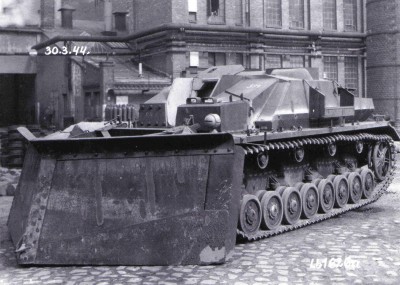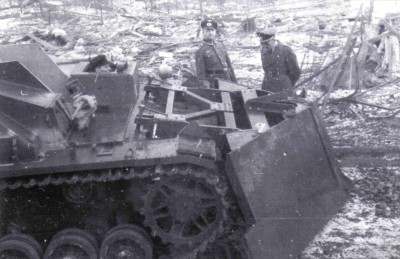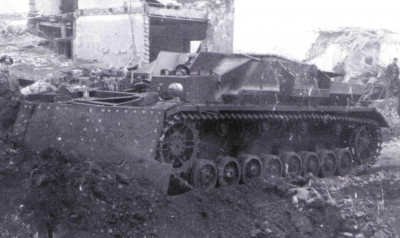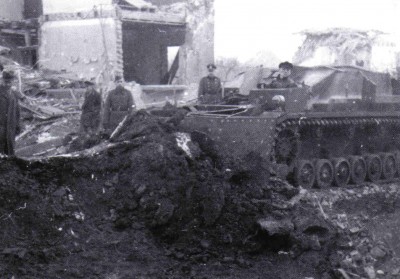| Název: Name: | StuG IV buldozér | StuG IV Buldozer |
| Originální název: Original Name: | Magdeburger Strassenräumgerät | |
| Kategorie: Category: | továrenská úprava pre čistenie vybombardovaných ulíc od trosiek | Factory treatment for cleaning bombed streets from debris |
| Výrobce: Producer: | DD.MM.1944-DD.MM.1944 Krupp, Magdeburg | |
| Období výroby: Production Period: | DD.MM.1944-DD.MM.1944 | |
| Vyrobeno kusů: Number of Produced: | ? | |
| Prototyp vyroben: Prototype Built: | DD.02.1944 | |
| Osádka: Crew: | 1-2 | |
| Technické údaje: Technical Data: | ||
| Bojová hmotnost: Combat Weight: | cca 26000 kg | cca 57320 lb |
| Celková délka: Overall Length: | ? mm | ? |
| Celková šířka: Overall Width: | ? mm | ? |
| Celková výška: Overall Height: | 2200 mm | 7 ft 2 ⅝ in |
| Světlá výška: Ground Clearance: | 400 mm | 400 |
| Pancéřování: Armour: | Pancierovanie: čelo korby a nadstavby - 80 mm boky korby a nadstavby - 30 mm zadok korby - 20 mm zadok nadstavby - 30 mm strop - 10 mm dno - 10 mm Pásy: Kgs 61/400/120 (99 článkov v jednom páse) | Armor: hull & superstructure front - 80 mm hull & superstructure sides - 30 mm hull rear - 20 mm superstructure rear - 30 mm top - 10 mm belly - 10 mm Tracks: Kgs 61/400/120 (99 links per side) |
| Pohon: Propulsion: | ||
| Typ: Type: | Maybach HL 120 TRM (vodou chladený zážihový 12-valec objemu 11.900 cm3) | Maybach HL 120 TRM (12 cyl., gasoline, water cooled, 11.900 ccm) |
| Výkon: Power: | 194.9 kW při 2600 ot/min | 261,4 bhp at 2600 rpm |
| Převodové ústrojí: Transmission: | ZF S.S.G. 76 (6+R) | - |
| Výkony: Performance: | ||
| Rychlost na silnici: Road Speed: | 25 km/h | 16 mph |
| Rychlost v terénu: Cross-country Speed: | ? km/h | ? mph |
| Jízdní dosah po silnici: Cruising Range on Road: | 80 km | 50 mi |
| Jízdní dosah v terénu: Cross-country Cruising Range: | ? km | ? mi |
| Překonávání překážek: Obstacles Crossing: | ||
| Svah: Gradient: | ? ° | ? % |
| Boční náklon: Side Slope: | ? ° | ? % |
| Překročivost: Trench Crossing: | ? m | ? |
| Výstupnost: Vertical Obstacle: | ? m | - |
| Brodivost: Fording Depth: | ? m | ? |
| Nástavba: Superstructure: | klinový pluh s nosným rámom | Wedge plow with support frame |
| Výzbroj: Armament: | žiadna | no |
| Uživatelské státy: User States: | | |
| Poznámka: Note: | - | - |
| Zdroje: Sources: | Mgr. Jan Vajskebr - Magdeburger Strassenräumgerät, HaPM č.3/2008, strany 22-25, ISSN: 1210-1427 | |
Odklízecí pluh montovaný na tankový podvozek (StuG IV)
StuG IV Buldozer
Magdeburger Strassenräumgerät
With the ongoing war and the ongoing bombing offensive of the Allied air forces, the need arose in German cities to develop effective means to remove the ruins of the destroyed residential infrastructure. A similar need arose in the city of Magdeburg. The initiative, based on the office of the local gauleiter of the Magdeburg-Anhalt county, has reached a remarkably simple solution. The removal plow was to be mounted on an armored vehicle, which would handle the extremely difficult task of removing a lot of rubble. The original intention was to use snow plows, but they were not designed for such a load. In cooperation with several institutions, other possibilities were sought. Another attempt was to use heavier highway plows, but even these were not suitable, respectively. the problem was to obtain a carrier of the appropriate load capacity of 4 to 6.5 tons with all-wheel drive, which was used for this activity. However, the branch of the company Krupp Grusonwerk A.G. was located in Magdeburg. The company produced as tanks Pz.Kpfw.IV and at the turn of 1943-44, the Magdeburg plant began to produce self-propelled guns StuG IV. This was a suitable carrier for a scrubbing plow. The company had design capacity at its disposal and managed to develop a plow of a more powerful construction, which was to be mounted on an available platform Pz.Kpfw.IV, resp. StuG IV.
The construction of the plow allowed to easily change the position of the blade above ground level, the construction itself weighed about 1.58 tons and the price ranged from 1200 to 1500 imperial marks. The device was not permanently mounted on the carrier, quick assembly and disassembly was required. The machine was named after the place of origin "Magdeburger Strassenräumgerät". The first deployment of this device took place on February 22, 1944 after a daily raid on the Magdeburg district of Cracau. The device proved to be extremely successful, the vehicle was able to work even when the height of the rubble was up to 80 cm. During the next two months, three plows were made, which were garaged separately so that they were not all destroyed in the event of a raid. The office of gauleiter Rudolf Jordan informed Heinrich Himmler [ Heinrich Himmler himself about the success of this solution in a letter dated 9 May 1944. He expressed the opinion that a similar device would find application in other places affected by the bombing. The equipment could, if necessary, be mounted on armored vehicles of tank units or production or repair plants located in the affected area. Himmler expressed interest and commissioned the commander of the SS Technical Academy and the police to test this solution. The commander of the academy was Prof. Dr. Gerloff. In 1942, the academy was moved to Veveří Castle near Brno. They had only two weeks to assess the proposal, Himmler expected that this device would be introduced as of June 15, 1944. Prof. Dr. Gerloff commissioned his subordinate, Lt. Col., to test. Winter Police to go to Magdeburg on June 6, 1944 and conducted thorough tests there. The tests took place the following day, June 7, 1944, directly on the site of a recently bombed factory. Three test sections were created. The first was 60 cm high with a cobbled street. The second was 80 cm high with a base of loose soil. The rubble consisted of small and large pieces of masonry with pipes, burnt beams, etc. The third was more than 1 meter high and the rubble consisted of large pieces of masonry and iron beams. The base was a slightly paved road. Each section was 30 meters long. The test vehicle successfully handled all sections. The only limit was the width of the street, which had to be at least 5 meters. If the width was smaller, the 3.4 meter wide blade would cause a blockage. The rubble would have no room to move it to the sides. The required amount of material of about 1.5 tons and the fuel consumption of the tank of 3 liters/km were acceptable due to the achieved performance. The blade itself was designed so that it can be used for other types of tanks. However, the use of vehicles over 20 tonnes was recommended.
The conclusions of the tests were presented to himself Adolf Hitler, who decided to use 10 tanks Pz.Kpfw.III or [ url=/topic/view/15043] Pz.Kpfw.IV[/url] from repair plants. The tanks were to be ready from the end of 6/1944 to the middle of 7/1944. The unofficial promise was that if possible, heavier tanks would be assigned Pz.Kpfw.IV. The assignment of individual machines to certain areas, which were many, was problematic. The solution consisted in the use of available vehicles in areas where tank units were located. The quick assembly, which lasted about 20 minutes, made it possible to use actively used armor. The production capacities of the company Krupp were used up, therefore the plow producers were to be local companies of individual districts of anti-aircraft defense. Drawings were to be provided by Krupp[/url=/topic/view/123796][/url]. The number of devices produced is unknown. The first three were probably joined by a dozen devices ordered by Adolf Hitler.
Mgr. Jan Vajskebr - Magdeburger Strassenräumgerät, HaPM No.3/2008, pages 22-25, ISSN: 1210-1427
The construction of the plow allowed to easily change the position of the blade above ground level, the construction itself weighed about 1.58 tons and the price ranged from 1200 to 1500 imperial marks. The device was not permanently mounted on the carrier, quick assembly and disassembly was required. The machine was named after the place of origin "Magdeburger Strassenräumgerät". The first deployment of this device took place on February 22, 1944 after a daily raid on the Magdeburg district of Cracau. The device proved to be extremely successful, the vehicle was able to work even when the height of the rubble was up to 80 cm. During the next two months, three plows were made, which were garaged separately so that they were not all destroyed in the event of a raid. The office of gauleiter Rudolf Jordan informed Heinrich Himmler [ Heinrich Himmler himself about the success of this solution in a letter dated 9 May 1944. He expressed the opinion that a similar device would find application in other places affected by the bombing. The equipment could, if necessary, be mounted on armored vehicles of tank units or production or repair plants located in the affected area. Himmler expressed interest and commissioned the commander of the SS Technical Academy and the police to test this solution. The commander of the academy was Prof. Dr. Gerloff. In 1942, the academy was moved to Veveří Castle near Brno. They had only two weeks to assess the proposal, Himmler expected that this device would be introduced as of June 15, 1944. Prof. Dr. Gerloff commissioned his subordinate, Lt. Col., to test. Winter Police to go to Magdeburg on June 6, 1944 and conducted thorough tests there. The tests took place the following day, June 7, 1944, directly on the site of a recently bombed factory. Three test sections were created. The first was 60 cm high with a cobbled street. The second was 80 cm high with a base of loose soil. The rubble consisted of small and large pieces of masonry with pipes, burnt beams, etc. The third was more than 1 meter high and the rubble consisted of large pieces of masonry and iron beams. The base was a slightly paved road. Each section was 30 meters long. The test vehicle successfully handled all sections. The only limit was the width of the street, which had to be at least 5 meters. If the width was smaller, the 3.4 meter wide blade would cause a blockage. The rubble would have no room to move it to the sides. The required amount of material of about 1.5 tons and the fuel consumption of the tank of 3 liters/km were acceptable due to the achieved performance. The blade itself was designed so that it can be used for other types of tanks. However, the use of vehicles over 20 tonnes was recommended.
The conclusions of the tests were presented to himself Adolf Hitler, who decided to use 10 tanks Pz.Kpfw.III or [ url=/topic/view/15043] Pz.Kpfw.IV[/url] from repair plants. The tanks were to be ready from the end of 6/1944 to the middle of 7/1944. The unofficial promise was that if possible, heavier tanks would be assigned Pz.Kpfw.IV. The assignment of individual machines to certain areas, which were many, was problematic. The solution consisted in the use of available vehicles in areas where tank units were located. The quick assembly, which lasted about 20 minutes, made it possible to use actively used armor. The production capacities of the company Krupp were used up, therefore the plow producers were to be local companies of individual districts of anti-aircraft defense. Drawings were to be provided by Krupp[/url=/topic/view/123796][/url]. The number of devices produced is unknown. The first three were probably joined by a dozen devices ordered by Adolf Hitler.
Mgr. Jan Vajskebr - Magdeburger Strassenräumgerät, HaPM No.3/2008, pages 22-25, ISSN: 1210-1427
Moravian Regional Archive
| Period | - |
| Type | - |
| Camouflage | - |
| Country | - |
| Production No. | - |
| Poznávací značka / evidenční číslo | - |
| Tactical marking | - |
| Name | - |
| Unit | - |
| Date (DD.MM.RRRR) | DD.MM.RRRR |
| Author | - |
| Print size / 300 DPI | - |
| Published with authors permit | - |
| Author Website | - |
| Period | - |
| Type | - |
| Camouflage | - |
| Country | - |
| Production No. | - |
| Poznávací značka / evidenční číslo | - |
| Tactical marking | - |
| Name | - |
| Unit | - |
| Date (DD.MM.RRRR) | DD.MM.RRRR |
| Author | - |
| Print size / 300 DPI | - |
| Published with authors permit | - |
| Author Website | - |
| Period | - |
| Type | - |
| Camouflage | - |
| Country | - |
| Production No. | - |
| Poznávací značka / evidenční číslo | - |
| Tactical marking | - |
| Name | - |
| Unit | - |
| Date (DD.MM.RRRR) | DD.MM.RRRR |
| Author | - |
| Print size / 300 DPI | - |
| Published with authors permit | - |
| Author Website | - |
| Period | - |
| Type | - |
| Camouflage | - |
| Country | - |
| Production No. | - |
| Poznávací značka / evidenční číslo | - |
| Tactical marking | - |
| Name | - |
| Unit | - |
| Date (DD.MM.RRRR) | DD.MM.RRRR |
| Author | - |
| Print size / 300 DPI | - |
| Published with authors permit | - |
| Author Website | - |
Reklama
Join us
We believe that there are people with different interests and experiences who could contribute their knowledge and ideas. If you love military history and have experience in historical research, writing articles, editing text, moderating, creating images, graphics or videos, or simply have a desire to contribute to our unique system, you can join us and help us create content that will be interesting and beneficial to other readers.
Find out more


